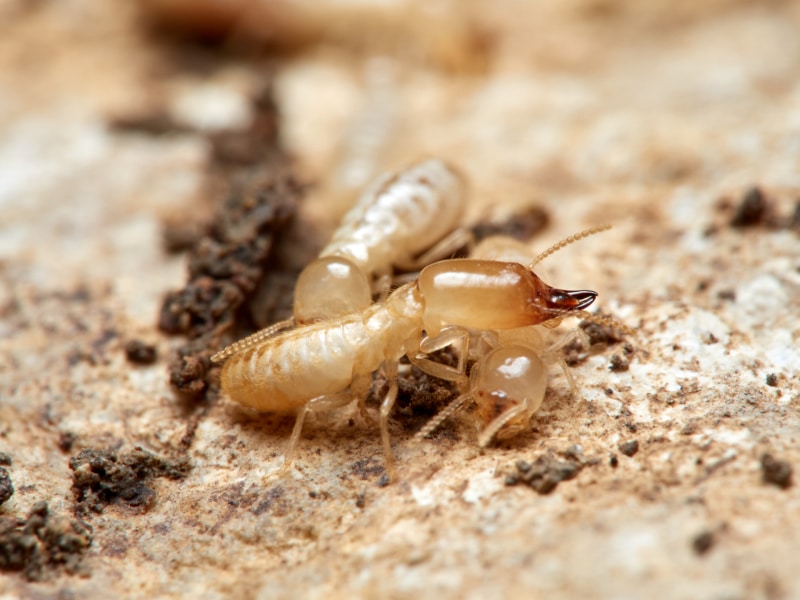
Termites are a common pest in Georgia. With high year-round temperatures and a humid climate, termites have everything they need to survive and thrive here. Georgia’s warm weather and moist soil make it a home for termite activity all year, especially in the spring and summer. If your home is not prepared, you could be at risk of a termite infestation that could potentially cause significant property damage. Here are the basics of what you need to know about termite control in Georgia.

Types of termites in Georgia
Termites are a common pest across the globe. There are over 2,000 different termite species worldwide, varying in shape, size, and behavior, with 45 of them found inside the United States.
The state of Georgia is home to three common termite species. (Hawx Pest Control offers treatment services for the first species in this list, the Subterranean Termite.)
Eastern Subterranean termite
The Eastern Subterranean termite is the most common termite speciate found across Georgia and the rest of the US. They’re an invasive species and the most aggressive termite you’ll find in Georgia. They’ll even chew through electrical wiring to get to more wood.
Eastern Subterranean termites are ground dwellers and enter your home through the flooring. They can squeeze through tiny gaps and will eat through rubber expansion joints to gain entrance if needed.

Formosan termite
Similar to the Eastern Subterranean, the Formosan termite is also a ground dweller that accesses homes by working through the flooring. Formosan termites in Georgia can move through gaps less than 1/16th of an inch wide. They live underground to stay near a constant source of moisture.

Drywood termite
Drywood termites in Georgia are less common but still cause damage, especially around coastal areas. They’re rarely seen in urban areas. Drywood termites enter the home through the attic of foundation vents that aren’t properly screened. They thrive on hard, dry wood inside the home, including structural timber, furniture, picture frames, and handrails. Because they live deep inside wood, they can be challenging to detect.

When do termites swarm in Georgia?
Each year, termites do something called swarming. This is where groups of flying termites called swarmers are dispatched from fully mature termite colonies to establish new termite nests. Swarming occurs periodically from spring to late fall, typically after rainfall.
Although the termite season in Georgia slows down in cooler months, it rarely comes to a complete end. Termite activity will continue as long as the temperature outside remains above 50 degrees.
What do termite swarmers look like?
Swarmers looks like normal termites but with long wings; the wings get shed when they’ve established a new colony, so it is common to find scattered wings on window sills and around other areas of the home if swarmers have been present.
Termite swarmers look very similar to flying ants. The main distinction lies in the termite swarmers’ oval-shaped bodies that differ from flying ants’ pinched waists. Flying termites also have longer wings and straight antennae, whereas flying carpenter ants have bent antennae.

How to make your home less attractive to termites
There are several simple steps you can take to discourage termite activity in your home, including:
- Remove organic and wood-based debris from your property, including lumber, sticks, leaf piles, cardboard, paper, and dead trees or stumps.
- Make sure your gutters are working properly and able to channel water away from your home’s exterior.
- Avoid using wood-based mulch products, especially near your home’s exterior.
- Fix leaky pipes inside your home and eliminate any sources of water buildup that might negatively affect the condition of your home’s wood.
- Use a caulking gun to fill in cracks, gaps, and holes in your home’s exterior foundation.
- Create a non-wood barrier between the exterior soil and your house.
- Keep an eye out for signs of termite nests.
How to tell if termites are active in furniture
The most recognizable sign of a termite infestation in furniture is their droppings, called frass, which resemble lighter-colored dry coffee grounds on or around the base of the furniture piece. You may also notice damage to surfaces, such as buckling paint, sunken spaces, or small holes in the interior parts of the furniture.
The best termite protection
Although you can take steps to discourage termite activity in your Georgia home, professional pest control is the best way to fully address the problem and remove an infestation. Hawx Pest Control offers reliable and effective termite control programs for subterranean termites, with the latest tools and technologies to address them on your property and help prevent future infestations. Give your home the protection it needs to stay safe during any time of year by contacting us today to get a free estimate for termite services at your Georgia property.
Categories
RELATED POSTS


